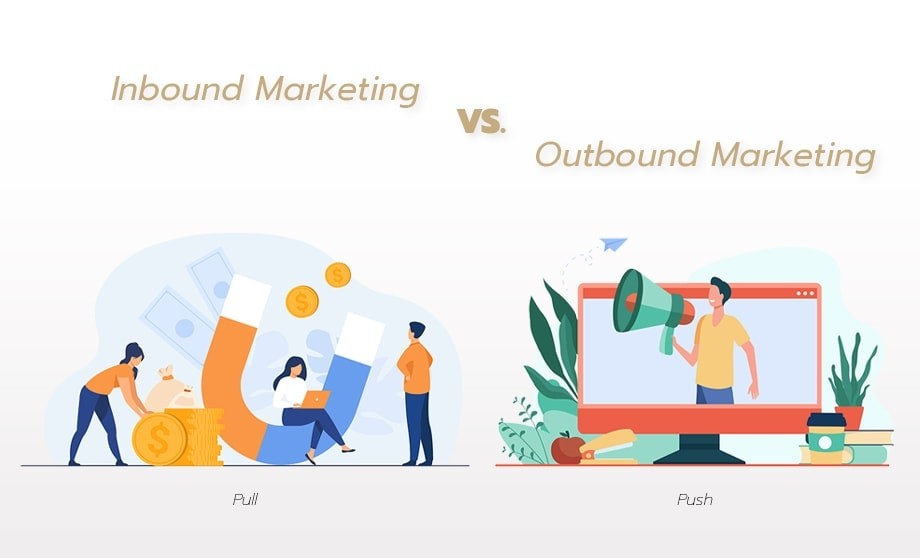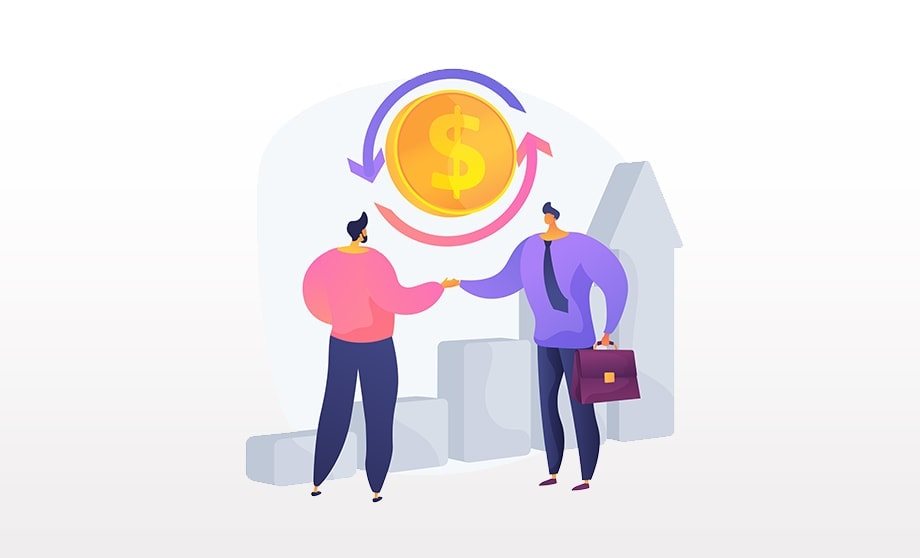From a summary by invesp and Hubspot, 41% of marketers globally confirm inbound marketing produces measurable ROI, and 93.7% of marketers find inbound Marketing a practical approach in the digital era, although it might take more than a year to see a glimpse of success. Apparently, a factor for success in inbound marketing is not big spending, but the time you spend to do it right. Still, too little budget could make it harder to reach the goal.
This shows the importance of starting off right with inbound marketing to eventually reap the fruit in the long run. It does not require a large investment to get some return. The devil is in the detail for inbound marketing, and today we will guide you to the basics of inbound marketing.
What is Inbound Marketing?
Inbound Marketing describes a form of marketing that attracts an audience and turns them into paying customers by creating valuable content and experiences tailored to them.

What sets Inbound & Outbound Marketing apart?
Outbound Marketing is the polar opposite of Inbound Marketing. While outbound focuses on pushing out what the brand wants customers to see or get, inbound provides value that customers will want to come asking the brand for it. Outbound marketing can sometimes be distracting and disrupting other activities the customers are trying to do.
When you put them for comparison, the differences seem a bit more obvious.
Inbound Marketing
Also called "Pull" marketing, it aims to attract consumers by providing value to help fulfil their demands.
Creating content based on what they need.
The audience gains from the content first, then gaining more from the brand's products and services.
Communicating mostly via owned media, such as the brand's website blog or Social Media accounts.
Outbound Marketing
Also called "Push" marketing, it is about pushing the brand message to make the audience know about its products and services.
Focuses on brand-related communication.
Chances are you can gain more customers that belong to other target groups.
Communicate via channels with a large follower base.
Despite what we have seen so far, it is still not easy to point out which one is better. It all depends on the business objective to choose the right approach for your brand. Maybe doing both at the same time could be the correct answer for you.
Let's say if your brand provides consumer products and needs to increase sales fast, Outbound marketing could bring you closer to your target.
If you aim for prolonged profitability and understand that some marketing approach consumes more time, or your brand offers niche products and services, inbound marketing could prove beneficial in the long run.
Combining the two could do you more good than harm, if you have enough budget, of course. You can promote the brand fast and to the face while creating value that will return sometime in the future.
You can get a headstart by focusing on outbound marketing to drive more sales, sustaining the brand with some revenue. After a while, your inbound marketing will start to spring, and people begin to recognize your brand. Then you can decrease your outbound marketing budget and focus on inbound marketing, which requires less budget or none at all.

Lastest Framework from HubSpot
In 2018, HubSpot developed the framework, from Funnel to Flywheel. This new framework puts the customer at the centre—marketers like us will workaround on the orbit, hence the name Flywheel.
Attract
This is the step where you bring strangers in to know more about your brand. But the strangers you bring in should match your planned target audience.
There are many tools to attract people, from writing engaging content on the website to promoting via social media platforms and continue to do retargeting to drive website traffic and convert.
Engage
This is the step after people has visited your website until they convert. The next step is to turn visitors into leads and eventually close sales.
E.g. by using forms, call to action, chatbot, or landing page. These tools are all made to increase the chances of turning visitors into leads while collecting information for marketing purposes, like email address, name, or telephone number.
After successfully turning them into leads, you should use different techniques to collect bits and pieces of information to get to know your target and deliver the best for their interest. Email Marketing, Marketing Automation, Live chat, Bot chat, and CRM system could come in handy.
This combines the Convert and Close steps from the former framework by Hubspot into one.
Delight
After you have acquired leads, you will want to strike a positive impression to make them fall in love with your brand, spread the words and help promote your products and services. This will prove significant, as people tend to be better persuaded by friends and relatives than the brand.
Maintaining a good relationship can be done by replying to them on social media posts, expressing gratitude, or personalise responses to make them feel special.
Giving out surveys or questionnaires to survey satisfaction in products and services helps improve your brand to meet their needs best. Knowing what makes customers choose to buy our products and services to identify how to provide better.
This means that you have to keep repeating the Delight step until the customer goes back into the Attract level and follows the wheel in a circle, allowing old customers to become new customers again.

Pros & Cons
What's good about inbound marketing?
It is cost-efficient. And if done right, you will continue to gain visitors even when you don't increase the budget.
It attracts people with the same interest because the brand does not shove the product into people's faces. Instead, they come to it to get something, making it easier to close sales.
The brand can build a solid fan base via the Delight steps, and eventually, they will become the brand's supporters who spread positive feedback and protecting it from bad words.
Having owned communication media can ready the brand for any change in the future.
What's the drawback of inbound marketing?
The brand has to monitor every media constantly. For example, a website is essential to attract visitors, and running a website requires annual maintenance costs.
It takes a long time to reach its potential, could be six months, one year, or more. But if you can endure that period, you can get free traffic from inbound marketing for a prolonged period.
It requires quality content to rank on search engines. SEO marketing requires thorough research, staying up-to-date on the news and innovative techniques all the time. Some companies lack a dedicated SEO content team to continually write blogs on their website, making it a bit harder. But trust me, it would pay to hire one.

Who Does It Suit Best?
Inbound marketing can be the most useful for high involvement businesses whose customers need to take time to do some product research before making purchase decisions. On the contrary, low involvement businesses are a better fit for outbound marketing, as customers only need emotional persuasion for small purchases. That said, the 3 most suitable high involvement businesses for inbound marketing are:
Business to Business (B2B)
Problem solvers e.g. law firms, agency
High-value businesses
Frequently Asked Questions
What are types of inbound marketing?
There are many forms of pull marketing that can be used to create brand awareness and attract new businesses—content marketing, blogs, events, search engine optimization (SEO), social media, and more
What is the difference between inbound and content marketing?
The main focus of inbound marketing is to encourage readers to perform an action such as inquire, buy a product, or complete a form. Content marketing focuses on creating and distributing content across multiple channels.
What are the five inbound principles?
There are 5 Principles of Inbound Marketing: standardize, contextualize, optimize, personalize, and empathize (S.C.O.P.E).
Is email marketing inbound or outbound?
Depending on your business and customer base, the ideal ratio of inbound and outbound could be different. Email marketing should be primarily inbound and complemented by more traditional outbound efforts, according to the general principle.
Is Facebook inbound or outbound marketing?
Outbound marketing is the most common use of Facebook Ads, where advertisers reach out to customers in order to get their message out. Inbound marketing also works by allowing your customers to come to you and establish relationships through valuable content that's relevant to them.
What are examples of outbound marketing?
Examples of outbound marketing include TV and radio ads, telemarketing, banner and display ads, billboards, newspaper and magazine ads, cold calling, pop-ups and pop-unders.
Need help planning inbound marketing strategies for your brand?
Suppose your brand falls under the 3 high involvement industry and look for some helping hands to do inbound marketing. In that case, our team at Sphere Agency is here to help you create compelling content that will catch the audience's eyes and turn them into prospective customers. See our Content Marketing Service and Contact us today!





